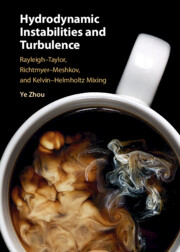 Hydrodynamic Instabilities and Turbulence
Hydrodynamic Instabilities and Turbulence from Part 1 - Fundamentals
It is critical to evaluate whether the flow has transitioned into turbulence because most of the impact of large-scale mixing occurs when the flow becomes fully developed turbulence. Hydrodynamic instability flows are even more complex because of their time-dependent nature; therefore, both spatial and temporal criteria will be introduced in great detail to demonstrate the necessary and sufficient conditions for the flow to transition to turbulence. These criteria will be extremely helpful for designing experiments and numeric simulations with the goal to study large-scale turbulence mixing. One spatial criterion is that the Reynolds number must achieve a critical minimum value of 160,000. In addition, the temporal criteria suggest that flows need to be given approximately four eddy-turnover-times. This chapter will expand on these issues.
To save this book to your Kindle, first ensure [email protected] is added to your Approved Personal Document E-mail List under your Personal Document Settings on the Manage Your Content and Devices page of your Amazon account. Then enter the ‘name’ part of your Kindle email address below. Find out more about saving to your Kindle.
Note you can select to save to either the @free.kindle.com or @kindle.com variations. ‘@free.kindle.com’ emails are free but can only be saved to your device when it is connected to wi-fi. ‘@kindle.com’ emails can be delivered even when you are not connected to wi-fi, but note that service fees apply.
Find out more about the Kindle Personal Document Service.
To save content items to your account, please confirm that you agree to abide by our usage policies. If this is the first time you use this feature, you will be asked to authorise Cambridge Core to connect with your account. Find out more about saving content to Dropbox.
To save content items to your account, please confirm that you agree to abide by our usage policies. If this is the first time you use this feature, you will be asked to authorise Cambridge Core to connect with your account. Find out more about saving content to Google Drive.